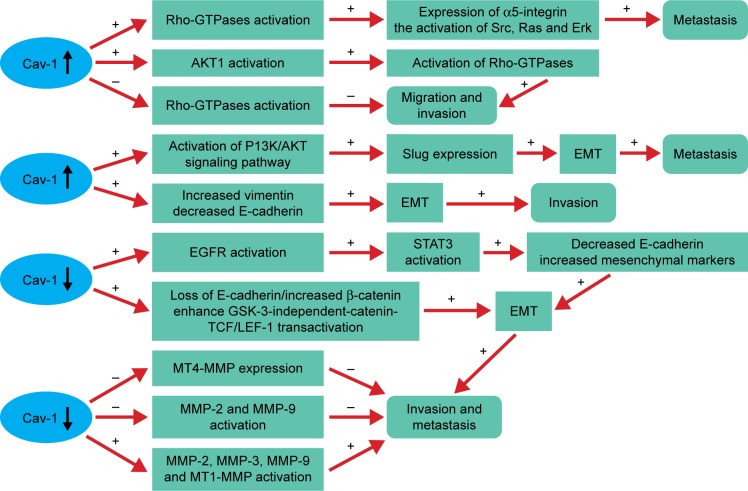Figure 1.
Cav-1 plays an important role in tumor migration, invasion and metastasis by regulating the activity of Rho-GTPases, EMT and MMPs.
Notes: Rho-GTPases: the cooperation between Cav-1 and Rho-GTPase can promote metastasis by the elevated expression of α5-integrin and the enhanced activation of Src, Ras and Erk.42 Moreover, Cav-1 overexpression can increase the phosphorylation of RhoC GTPase by stimulating the activation of AKT1,43 whereas the opposite result exists in pancreatic cancer.44 EMT: Cav-1 overexpression promotes bladder cancer metastasis via inducing EMT by activating the PI3K/AKT signaling pathway, which upregulates Slug expression.14 The decreased expression of Cav-1 can also enhance cancer cell invasion and metastasis by the downregulation of E-cadherin, upregulation of β-catenin and enhancing GSK-3-independent-catenin-TCF/LEF-1 transactivation47 or by stimulating EGFR, then promoting the activation of STAT3, resulting in contributing to the EMT.46 MMPs: Cav-1 mediates tumor invasion and metastasis by negatively regulating the activity of MMP-2, MMP-9 and the expression of MT4-MMP54,55 or by positively regulating the activity of MMP-3 and the expression of MMP2, MMP-9 and MT1-MMP.45,50 The “+” represents the promotion and “−” represents the inhibition.
Abbreviations: Cav-1, caveolin-1; EGFR, epidermal growth factor receptor; EMT, epithelial-to-mesenchymal transition; GSK, glycogen synthase kinase; LEF, lymphoid enhancer factor; MMPs, matrix metalloproteinase; MT, membrane type; PI3K, phosphatidylinositol 3-kinase; STAT3, signal transducer and activator of transcription 3; TCF, T-cell factor.

